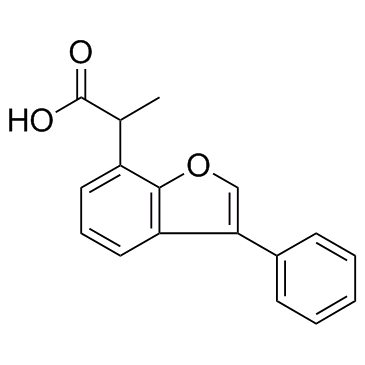furaprofen
Modify Date: 2024-01-10 12:01:57

furaprofen structure
|
Common Name | furaprofen | ||
|---|---|---|---|---|
| CAS Number | 67700-30-5 | Molecular Weight | 266.29100 | |
| Density | 1.23g/cm3 | Boiling Point | 449.4ºC at 760 mmHg | |
| Molecular Formula | C17H14O3 | Melting Point | N/A | |
| MSDS | N/A | Flash Point | 225.6ºC | |
Use of furaprofenR803 is an effective HCV replication inhibitor. R803 is substantially more potent against genotype 1a and 1b replicons (EC50, ~30 nM) than against the genotype 2a replicon (EC50, ~1,000 nM). |
| Name | furaprofen |
|---|---|
| Synonym | More Synonyms |
| Description | R803 is an effective HCV replication inhibitor. R803 is substantially more potent against genotype 1a and 1b replicons (EC50, ~30 nM) than against the genotype 2a replicon (EC50, ~1,000 nM). |
|---|---|
| Related Catalog | |
| Target |
EC50: ~30 nM (HCV genotype 1a and 1b replicons), ~1000 nM (HCV genotype 2a replicon)[1] |
| In Vitro | R803 is potent and highly specific for HCV replication. The antiviral activity of R803 has been determined by a reporter replicon assay with multiple repeats to be 29.88±8.05 nM, an ~3-fold improvement over the activity of the parent compound, R706. The potency of R803 against the replicon is also confirmed by both Western blotting and TaqMan RT-PCR to be about 37 nM and 54.67±4.11 nM, respectively . To assess the general effect of R803 on cell proliferation, a panel of primary cells and transformed human cell lines are treated with increasing doses of R803 for 48 h, and the effect on cell proliferation is measured by an MTS-based cell viability assay. The the concentration that caused a 50% reduction in cell numbers in the absence of virus infection (CC50) of R803 is found to range from 2 μM to ≥10 μM, depending on the cell type and proliferation status[1]. |
| Kinase Assay | Plasmid PV-Luc is linearized with the PvuI restriction enzyme and subjected to in vitro transcription using the RiboMAX Large Scale RNA Production System-T7. After DNase I digestion and purification, the transcribed RNA (5 μg) is electroporated into Huh-7 cells at 270 V and 950 μF on a Gene Pulser II system. The cells are then dispensed into white 96-well plates at a density of 10,000/90 μL/well. R803 is serially diluted in compound diluent (10% DMSO, 20% methanol) and added to each well in a volume of 10 μL. The plates are incubated for 18 h at 37°C under 5% CO2 before luciferase activity is determined using the Bright-Glo luciferase assay kit[1]. |
| Cell Assay | Replicon 9-13 cells are plated onto 6-well plates 24 h prior to the treatment. Serial dilutions of R803 are made in a mixture containing 90% of the culture medium, 7.2% 1× PBS, 1.8% methanol, 1% DMSO, 20 μM RBV, and varying concentrations of IFN-α for a fixed-ratio dose-response study. The cells are treated with the designated combinations of R803 (0 to 80 nM concentrations) and IFN-α (0 to 4 IU/mL) plus 20 μM RBV for 72 h; then they are washed with PBS, lysed in SDS loading buffer, and analyzed by Western blotting[1]. |
| References |
| Density | 1.23g/cm3 |
|---|---|
| Boiling Point | 449.4ºC at 760 mmHg |
| Molecular Formula | C17H14O3 |
| Molecular Weight | 266.29100 |
| Flash Point | 225.6ºC |
| Exact Mass | 266.09400 |
| PSA | 50.44000 |
| LogP | 4.28790 |
| Index of Refraction | 1.627 |
CHEMICAL IDENTIFICATION
HEALTH HAZARD DATAACUTE TOXICITY DATA
|
| R803 |